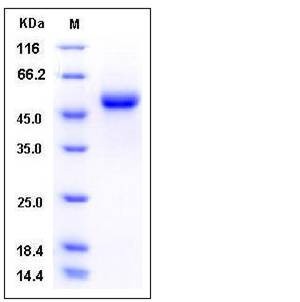Human alpha-Galactosidase A / GLA Protein (His Tag)
GALA
- 100ug (NPP3577) Please inquiry
| Catalog Number | P12078-H08H |
|---|---|
| Organism Species | Human |
| Host | Human Cells |
| Synonyms | GALA |
| Molecular Weight | The secreted recombinant human GLA consists of 409 amino acids and has a predicted molecular mass of 46.8 kDa. In SDS-PAGE under reducing conditions, it migrates as an approximately 50 kDa band. |
| predicted N | Leu 32 |
| SDS-PAGE |  |
| Purity | > 97 % as determined by SDS-PAGE |
| Protein Construction | A DNA sequence encoding the human GLA (NP_000940.1) (Met 1-Leu 429) was fused with a polyhistidine tag at the C-terminus. |
| Bio-activity | |
| Research Area | Immunology |Inflammation / Inflammatory Mediator |Lysosomal Enzymes |
| Formulation | Lyophilized from sterile 50mM Tris, 150mM NaCl, pH 7.5 1. Normally 5 % - 8 % trehalose and mannitol are added as protectants before lyophilization. Specific concentrations are included in the hardcopy of COA. |
| Background | Alpha-galactosidase A, also known as Alpha-D-galactoside galactohydrolase, Alpha-D-galactosidase A, Melibiase and GLA, is a member of the glycosyl hydrolase 27 family. GLA is used as a long-term enzyme replacement therapy in patients with a confirmed diagnosis of Fabry disease. Defects in GLA are the cause of Fabry disease (FD) which is a rare X-linked sphingolipidosis disease where glycolipid accumulates in many tissues. The disease consists of an inborn error of glycosphingolipid catabolism. FD patients show systemic accumulation of globotriaoslyceramide (Gb3) and related glycosphingolipids in the plasma and cellular lysosomes throughout the body. Clinical recognition in males results from characteristic skin lesions (angiokeratomas) over the lower trunk. Patients may show ocular deposits, febrile episodes, and burning pain in the extremities. Death results from renal failure, cardiac or cerebral complications of hypertension or other vascular disease. Deficiency of GLA leads to the accumulation of glycosphingolipids in the vasculature leading to multiorgan pathology. In addition to well-described microvascular disease, deficiency of GLA is also characterized by premature macrovascular events such as stroke and possibly myocardial infarction. |
| Reference |
